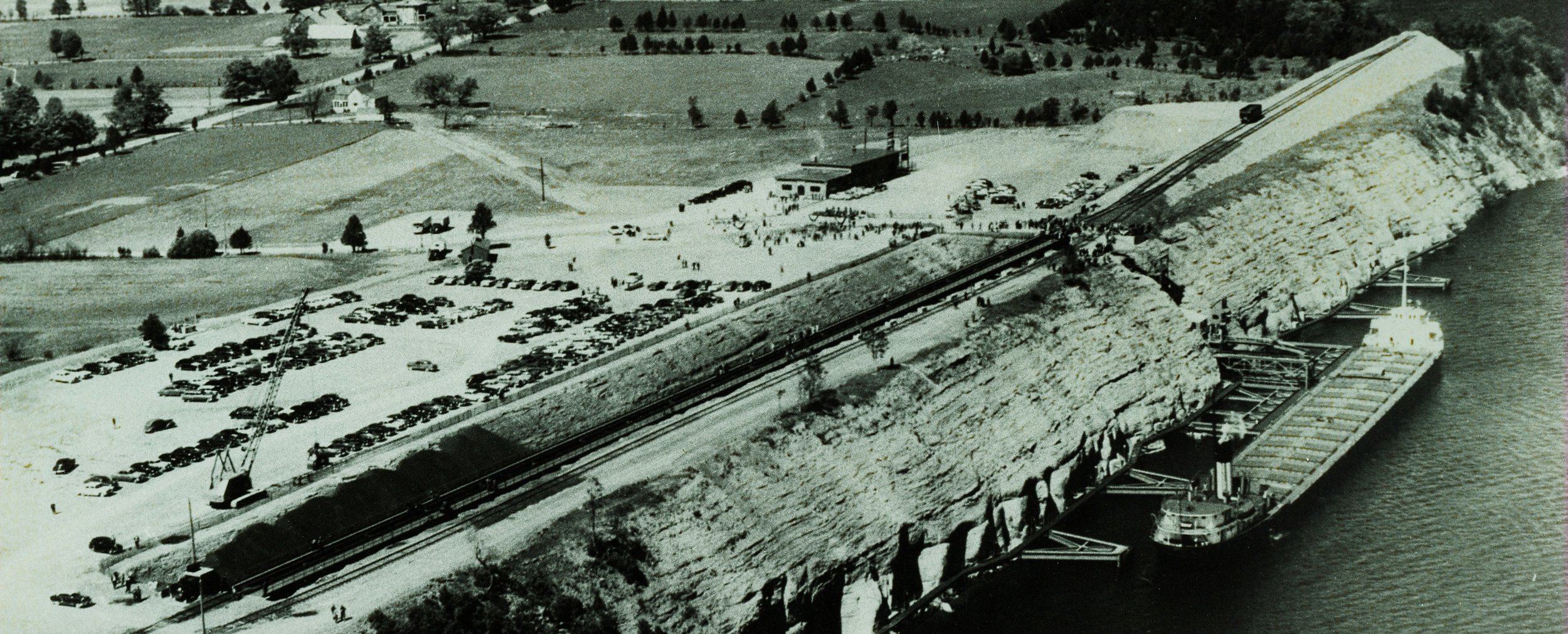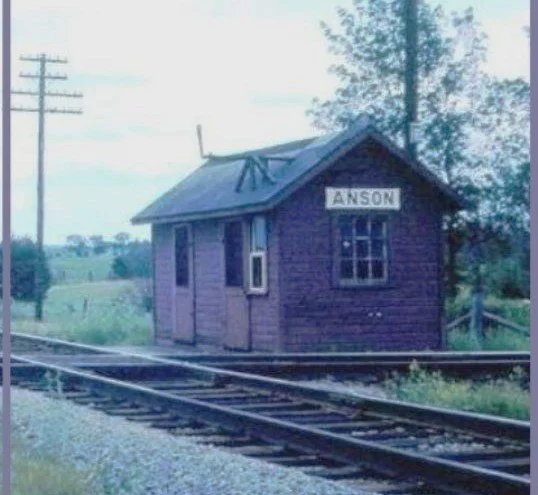ST. ANDREW'S PRESBYTERIAN CHURCH
Well made, truly laid, well proved, true and trusty
1899-1925
CIRCA 1913 This Church, on the corner of McGill and William Streets, stood on the site of the present day Marmora Free Methodist Church.
Prior to the erection of the Presbyterian Church, the St. Andrew's record states members of this faith attended services held in the Masonic Hall from 1890 to 1900. (However, the "Handbook of the Presbyterian Church in Canada" makes reference to Rev. David Beattie, ordained in 1857 as a missionary, tending the Marmora Presbyterian Church and the Rylestone Presbyterian Church in 1883)
The Presbyterian Church, was supplied by Queen's University Theological students. One of these was Reverend John Inkster, in 1900, a clever man who later became one of the outstanding Presbyterian Ministers and occupied the pulpit of Bloor Street Presbyterian Church in Toronto. Through his efforts, the Presbyterian Church, fondly known by all as "The Little Church on the Hill", was built in 1901
Rev. Inkster remained as minister of the church until 1902 and was succeeded by the Rev. Robertson who left during 1903. Others who gave leadership with this congregation were Mr. McGuinness , P.L. Tedford , and E.V. Forbes. It was during this time, 1901 or 1902, that Mr. George MacQueen, an accountant of Deloro and the son of a Scottish minister, came to Marmora, and for the next two decades, was the main pillar of the church. He was affectionately known to all the youngsters as "Uncle Boogie". Approximately twenty families comprised the adherents of St. Andrew's Presbyterian Church. Some of the faithful families were the Linns, Sweets, Connors, Froats and MacKechnies.
Ada and Frank Sweet in front and Bess Sweet and George Froats in back. Ada and Frank's wedding according to the note on the back.
From 1903 on, theological students from Queen 's University travelled to Marmora and conducted the Sabbath services as well as taking an active part in the Sunday School. Some of the student pastors who served here 'Were. R. P. Jull, Felford, Orok, Walker. Acton and' E. V. Forbes. They were billeted in the homes of members of the congregation and reimbursed the sum of twenty dollars for their services. From this amount they had to pay their travelling expenses. Many of these theological students attained prominence in the Presbyterian Church of Canada in later years.
.The above arrangements were carried on over a decade, and for a few years, prior to the closing of"the church due to financial conditions and dwindling congregation, Mr. George MacQueen conducted the services. On the closing of the church, in 1923, the remaining members of the congregation attended· the Marmora Methodist Church. In 1925 "The Little Church on the Hill" was sold to the members of the Free Methodist Church.
While water mains were being laid for the local water system,
a blast wrecked the building in 1958 and it was replaced by the
Free Methodist congregation with a very modern church in 1960,
Penny Barrons added: There were also Free Methodist Churches at Beaver Creek (it is still there) and at North Marmora.
Masons Laying of the Cornerstone Excerpt from Masonic Records
An Especial Communication of the Grand Lodge of A. F. d: A. M. of Canada, held in the Masonic Hall, in the Village of Marmora, on Tuesday, 13th day of June, A.D. 1899, A. L. 5899 had been called for the purpose of laying the foundation stone of the Presbyterian Church in Marmora. The Reeve of the township of Marmora and members of the Township Council were announced and introduced and the Reeve read the following:
"To E. T. Malone, Esq., Grand Master of the Grand Lodge of Free and Accepted Masons : Most Worshipful Sir, —
It is with feelings of the sincerest pleasure and pride that I, as Reeve of the Townships of Marmora and Lake, on behalf of the Council and citizens, extend to you now a most hearty welcome to the village of Marmora.
Our village until a few years ago was the center of one of the most extensive lumbering districts in the Province of Ontario. Now, however, the supply of timber is almost exhausted. At present the mining industry is nourishing, the iron mines are beginning to work in consequence of the boom in the iron trade; and at least two of our gold mining companies are working day and night turning out regularly fine bricks of the precious metal. I hope you will have the privilege of inspecting them while here.
Our village may seem small to you coming from the city of Toronto; but when I mention a small bit of Masonic history you will see that when Marmora village was founded Toronto was not very extensive. At the time Morgan was creating some excitement, I cannot tell the exact date, some seventy-five or eighty years ago, there was a meeting of the craft called at New York for the purpose of taking his case in consideration. A delegate attended that meeting from Marmora. He recommended that Morgan be kept on a farm in the back woods of Canada — the farm I now occupy — not a very hard sentence if it had been carried out.
As a member of the craft myself, it gives me great pleasure to have you with us to-day to assist in laying the cornerstone of this nice little church, and if at some future time you would like to spend a few weeks on our magnificent rivers and lakes, you may depend on a warm reception from the citizens of Marmora. "
WILLIAM HILTON, Reeve. WM BONTER, & JAS. H. WARREN.
An address was also presented to the M. W. the Grand Master by the W. M. and officers of Marmora Lodge, No. 222. To both addresses the M. W. the Grand Master made suitable responses.
The brethren acting as Grand Lodge officers having received the necessary directions, Grand Lodge was called off and a procession formed under the direction of W. Bro. R. B. Proutt, acting Grand Director of Ceremonies, and marched to the site in prescribed order, taking their proper positions at the northeast corner of the building. .................
This Corner Stone of the Presbyterian Church of Marmora.was laid by M. W. E. T. Malone, Grand Master, assisted by the Grand Officers, and in presence of a large concourse of brethren and citizens of the County of Hastings.
A handsome silver trowel, suitably inscribed, was presented to the M. W. the Grand Master, by the Rev. John G. Inkster, B. A., Pastor of the church.
The Grand Wardens and the Deputy Grand Master applied the implements of their offices to the stone, after it had been placed in position, and announced that the craftsmen had done their duty.
The M. W. the Grand Master then consecrated the stone with corn, wine and oil, and pronounced it :
WELL MADE, TRULY LAID, WELL PROVED, TRUE AND TRUSTY.
The procession was then reformed, the brethren returned to the Masonic Hall, and Grand Lodge was closed in ample form.
Below: View looking east across Crowe River, Pearce Lumber Mills & Presbyterian Church on top of the hill on McGill Street
Original Presbyterian Church with Bruce Airhart house in the background.
Pulpit of the original Presbyterian Church, saved from fire by Reverend Glover. It is now at the Marmora Historical Foundation
































